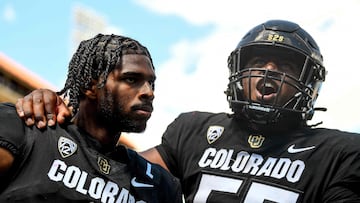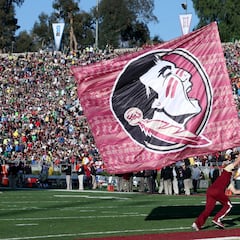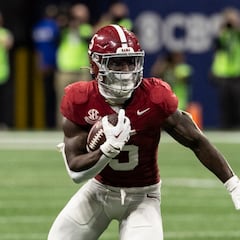Who is the highest paid college athlete? NIL endorsement deal money in NCAA sports
Following the implementation of a new rule allowing college athletes to profit from their name, image, and likeness the landscape has changed forever.


If you don’t understand the situation surrounding NIL money and college athletes, then don’t worry, we’ve got the low down on what it’s all about.
The NIL money debate
After decades’ worth of petitions finally saw the NCAA change its policies where earning NIL money is concerned, college athletes can now rejoice. In the wake of the monumental decision, universities and major brands nationwide have been in a frenzy to understand what said changes mean and, more importantly, how they can benefit from them. Indeed, that fervor is not just limited to those institutions, with athletes scrambling nationwide to understand exactly what they can and can’t do where NIL money is concerned.
Ducks QB Dillon Gabriel is a poster child for what's wrong with NCAA football today. Oregon is his third school in four years. He's a mercenary chasing NIL money, not a student-athlete pursuing an education. Is he even enrolled in classes at Eugene? 🙄 pic.twitter.com/MmqnbleO8f
— Donald R. Koelper (@Donald_from_HI) October 12, 2024
There is, of course, a great deal of information out there regarding the signing of NIL endorsement deals, but it should be noted that there is much less available in terms of how an athlete can acquire a NIL deal and just how much one can be worth. With that said, we aim to answer those questions and a few more, so join us to look at how NIL money works in the college game today.
What does NIL stand for?
NIL stands for Name, Image, and Likeness. As explained before, college athletes can now be paid by companies who want to use them to promote their products.
What is NIL money?
The term ‘NIL money’ refers to money that an athlete can earn by signing an NIL contract, allowing the athlete to market their personal brand. Where the exact amount of money received is concerned, it’s important to note that it depends on factors such as social media following, market value, and the actual sport in question. At present, football and basketball players receive the largest compensation in the NIL market, but that’s not to say that NIL contracts don’t exist in other sports either.
How do athletes earn NIL money?
Though there are varying ways in which athletes can earn NIL contracts, the most common are as follows:
- Accepting direct payments for promotional activities
- Receiving free or sponsored products in exchange for promotion
- Receiving free or sponsored services in exchange for promotion
- Earning affiliate money from social media promotion
- Becoming an ambassador for a brand or business
- Appearing in commercials, ads, and digital content
To date, there are more than 450,000 student-athletes across the United States who have earned NIL money by partnering with local businesses in promotions. Interestingly, some of those athletes have even managed to enter into deals with big brands, resulting in things like training clinics as well as autograph and photograph opportunities at corporate events. Even a select few have managed to be featured in commercials for businesses.
Touched by students’ struggles, San Diego St. men’s basketball team pledges NIL money to support food pantry https://t.co/aqZiTkapn6 pic.twitter.com/mH3YTaHxVw
— Orlando Sentinel (@orlandosentinel) January 1, 2025
With all that said, it still seems that the most straightforward way to earn NIL money is by utilizing social media influence. That’s right, if you’ve got enough of a following on social media, that can be translated into lucrative sums of money by agreeing to post sponsored content. Even nano-influencers – athletes with about 10,000 followers – can profit from their social media followings.
How much money can college athletes make with a NIL deal?
Broadly speaking, the average income from NIL deals for student-athletes ranges from $1,000 to $10,000. However, we’ve seen cases where some athletes have earned much more than that. Those cases, as mentioned above, were directly tied to the sport in question, the projected success of the athlete, and the social media following, which, as you can imagine, was sizeable.
Sanders leads the way in 2024
Colorado Buffaloes quarterback Shedeur Sanders is not only turning heads on the field but also boosting his bank balance in off field marketing deals.
Sanders is already college football’s top earner, according to On3 Top 100 valuation with an impressive $6.2 million thanks to his sponsorship deals with Nike, Gatorade, BRADY, Mercedes-Benz.
Arch Manning is a perfect example of his family helping boost his valuation for the quarterback for the Texas Longhorns.
BREAKING: Nike has signed Colorado QB Shedeur Sanders to a NIL footwear & apparel deal. 📄✍️ pic.twitter.com/4M8oWVzijO
— Nick DePaula (@NickDePaula) August 28, 2024
NCAA athletes with the biggest endorsement deals (2024)
1) Shedeur Sanders – Colorado Football $6.2M Valuation
2) Travis Hunter – Colorado Football $5.2M Valuation
3) Arch Manning – Texas Football $5M Valuation
4) Livvy Dunne – LSU Gymnastics $4.2M Valuation
5) AJ Dybansta – BYU Basketball $2.8M Valuation
6) Jalen Milroe – Alabama Football $2.7M Valuation
7) LaNorris Sellers – Alabama Football $2.7M Valuation
8) Cooper Flagg – Duke Basketball $2.7M Valuation
9) Quinn Ewers – Texas Football $2.4M Valuation
10) Ryan Williams – Alabama Football $2.4M Valuation
Arch Manning ain’t going anywhere, per Arch Manning 😂🤘 pic.twitter.com/qTAfopxFKT
— Rivals (@Rivals) December 30, 2024
Related stories

Georgia vs Florida State: how to watch

Alabama vs Michigan: how to watch
Ultimately, NIL deals are here to stay, but what effect that has on young college athletes and, moreover, institutions’ ability to recruit them remains to be seen. Watch this space.
Get your game on! Whether you’re into NFL touchdowns, NBA buzzer-beaters, world-class soccer goals, or MLB home runs, our app has it all. Dive into live coverage, expert insights, breaking news, exclusive videos, and more – plus, stay updated on the latest in current affairs and entertainment. Download now for all-access coverage, right at your fingertips – anytime, anywhere.
Complete your personal details to comment